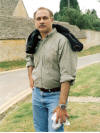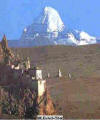|
|
the-south-asian.com July / August 2006 |
|
|||
|
August/September Contents
Sufis
- wisdom against 50
years of mountain Heritage cities:
Cotton - the fibre of
|
|
||||
|
Page
1 of 7
50 years of
Climbing – Everest, K2, & Nanga Parbat by Salman S. Minhas: Information Engineers, Lahore, Pakistan
"If the world's leaders could spend a few days climbing a mountain together, then things would go better.” -Reinhold Messner – Interview Ed Douglas, Sunday March 30, 2003 the Observer
Background &
Introduction
Sacred Mountains & God’s Thrones
Mt. Olympus [ 2917
meters ] in north Greece was considered by Greek mythology as the house of
the Greek Gods [ Zeus- ruler of all gods, his wife Hera , Apollo, Athena,
Aphrodite, Hermes, Artemis, etc ]. Since 2000 B.C. Mt.Kailash [22K feet]
located in Tibet, has been considered by Hindus, Buddhists and Jains to be
the home of Shiva. About 1000 pilgrims each year go there on foot from
India. It is considered a sort of a cosmological center / energy field.
Not far from Mt. Kailash
are two pristine turquoise blue lakes. One is called Mansarovar [ meaning
“perpetually invincible” and the soul of Brahma] and the second is called
Rakhshas[ Ghost Lake] . The area within the nearby 100 kilometers is the
origin / source of 4 rivers including the Indus, Sutlej, Brahmaputra, &
Karnili / Ganges. [The four sources, each in the shape of a horse, lion,
elephant and peacock, have given names to the four famous rivers in the
Ngari area].
Mountains in the Himalayas are also named after religious icons – for
Tibetans the Everest is “ Chomolungma “ or Mother Goddess of the Universe &
for the Nepalese Buddhists, Everest is “ SagarMatha“ or Mother of the Ocean
(perhaps a reference to the origin of the Himalayan range from the Tethys
Sea). Similarly the others Himalayan 800+ peaks have names related to
Goddesses. Annapurna means the Goddess of Harvest and Bounty. The name
Nanda Devi means “Blessed Goddess.” At 25,645 feet the monastery of
Tengboche near the first Base camp of Mt.Everest is known for bestowing
blessings to all Everest climbers. The word Karakoram means black rock; in
Turkish, Karakoram means “crumbling rock” or scree. Himalayas
in Sanskrit means the abode of snow.
Jamling Norgay, the son
of first Everester Sherpa Tenzing Norgay (Tenzing and Hillary were the
first to scale the Everest in May, 1953), once said in an interview:
"You know…we look on the mountains as sacred, and to this day some of the
Himalayas remain
off limits to us. They are such holy mountains that to climb them would be
wrong……………for many of us - especially on Everest - mountain-climbing has
become our livelihood. But we go to the mountain with respect. We know that
Chomolungma lives there, and so prayer and ceremony must precede any attempt
to climb the mountain…We place prayer flags wherever we go (on these treks).
Chomolungma, the maiden of the wind and mother goddess of the world, lives
on Everest, and our prayers are to her by the wind horse. The flags blowing
in the wind are the sound of our prayers, our communication with the
goddess. In prayer, we learn the respect with which we must approach the
mountain. The deities can be defiled by people who abuse the mountain, who
pollute it with garbage or try to climb it without showing proper respect.
Ignorant people sometimes climb mountains; they climb only as an expression
of ego. It is very important that climbers respect the mountain and the
people who live there."
In 1986, the American Climber Galen Rowell [ he and his wife died in a plane crash in USA in 2002] referred to the area at Concordia in the Karakorams as “ The Throne Room of the Mountain Gods” and wrote a fine book with the same title .
Of Men & Mountains – Explorers, Surveyors & Early History [500 BC – AD 1800]
K2 was the name given by
a British colonel T.G. Montgomery in 1856, who was carrying out a
trignometric survey of the area. He named the peaks in the order he saw
them, K1, K2, K3, etc. The K stands for Karakoram. Only K2 retains its
name. The rest are called by their local names. K2 [8,611 meters] was
climbed by the Italians Lino Lavedelli [aged 29] and Achille Compagnoni
[aged 39] on July 31, 1954 after a century of exploration. The word “discovery” is now a fuzzy word at best, after it has been confirmed that the Vikings and the Indians crossed the North Atlantic and Bering Straits. The Arabs and the Chinese traded with India using sea routes to Cochin exploiting nature’s trade winds as far back as the year AD1000 - AD1500. Central Asia was famous for its “Silk Route”. The areas around the Karakorams have plenty of evidence that the current Karakoram Highway uses pretty much the same route as one of the many arms of the Great “Silk Route”. In any case in 1856, British surveyor Captain T.G. Montgomery of the Great Trignometric Survey of India sighted the cluster of peaks from about 100 + miles away and entered them as K1, K2, K3, K4, the K standing for the Karakoram Range. The modern day documentation and map making had begun. This was a requirement of the
Paiyu which is a camping
spot en route to Concordia was used by Balti herdsmen who must have been the
first to spot K2, according to Galen Rowell, the American climber [ G.Rowell
–“In the Throne Room of the Mountain God’s” ]. Rowell believed that Mustagh
La [Pass] was in use as he mentions evidence of a Polo Ground [160 feet by
800feet] at the village of Sharagan near the Mustagh Glacier. Sir Francis Younghusband, a noted soldier and adventure traveler, also in 1887, crossed the Gobi desert from Peking and entered India by crossing Mustagh La Pass [Mustagh means ice-tower in Balti]. It was during this journey that he saw K2.
Later in 1909, the
Italians came to the Karakorams in the form of a great expedition with
almost 250 porters. The Duke of Abruzzi arrived along with the famous
photographer Vittorio Sella. Sella’s travels took him on expeditions
to the Caucasus starting in 1889 to Alaska -1897, to Sikkim & Nepal -1899,
to the Ruwenzori in Africa-1906, and to the Karakorams and Western
Himalayas-1909.
Sella’s seminal book on
the Karakorams was called:
“Summit” : Vittorio Sella : Mountaineer and Photographer : The Years
1879-1909
by
Vittorio Sella,
Paul Kallmes,
Wendy Watson,
Fondazione Sella,
Mount Holyoke
College Art Museum,
Gallery of the New
York School of Interior Design,
Whyte Museum of
the Canadian Rockies,
New York School of
Interior design ,
Ansel E. Adams
: publisher - Aperture.
“Summit” was prefaced by
Ansel Adams, who considered him the greatest mountain photographer. In 1946,
Ansel Adams wrote in the Sierra Club Bulletin:
"The memory of Vittorio Sella is closely embraced by the moods of the
world's great mountains, many of which are known to us chiefly through the
beautiful imagery of his lens. Mighty K2, shrouded in gray plumes of the
Monsoon, these are revealed in all their sheer majesty in Sella's masterful
photographs." Nanga Parbat - the Killer Mountain K2 - the most difficult mountain to climb Women on Nanga Parbat, K2, and Mt.Everest
|
|||||
|
Copyright © 2000 - 2006 [the-south-asian.com]. Intellectual Property. All rights reserved. |
|||||


